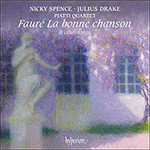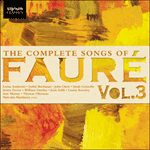This is a justly famous song, one that would number in most people’s top-ten hit-parades of Fauré’s mélodies. It is little wonder, for the grandeur of these ‘horizons navrants’ has inspired a setting of genius. This is the second of three Silvestre settings (out of ten) which opt for drama rather than charm; the others are
Le voyageur, and
Fleur jetée. The key is B minor, a colour which is exactly right for October storms; in fact the song sounds unconvincing in any other tonality. An opening bar of empty, restless triplets churns in the pianist’s right hand; leaping on to the next available bar-line the left hand jumps a fifth in octaves – B to F sharp – before plunging a sixth down to A natural, and thence down to G sharp. The rhetoric of this writing is intensified by the kick of syncopation, something bitter and querulous. This process is repeated, once again in octaves: up to F sharp, and then down a seventh to a G natural which resounds again before settling on an F sharp in the bowels of the instrument. There is something circular about this billowing piano-writing, like the movement of a windmill, which punctuates the voice’s outbursts. (Seasons come round again and again with this inevitable pull – the turning of the world.) And then one realizes that this song is about memory, and the impossibility, even as one’s mind moves in circles, of having one’s time over again (see also
Prison). At the time of its composition Fauré was thirty-five, just old enough to look back on his youth with regret. It is a miracle how, in the midst of this bluster, a pianistic interlude of the purest sweetness and calm is allowed to flower as an introduction to the middle verse of this ABA structure. This section leads to the ache of ‘Où jadis sourit ma jeunesse’, but this is capped by one of the most powerful vocal climaxes in the French mélodie – a high F sharp – at the end of the phrase ‘Mes vingts ans avaient oubliées!’ The postlude sits in judgement and finds the defendant guilty, first with vehemence, and then with a shudder of cold indifference. Once again the poem’s publication in 1880 (as ‘Chanson d’automne’ in
Les ailes d’or) postdates the composition of the song.
from notes by Graham Johnson © 2005
C’est une œuvre fameuse à juste titre, de celles que la plupart des gens feraient figurer au «top-ten» des mélodies de Fauré. Ce qui n’a rien de surprenant, tant le grandiose de ses «horizons navrants» a inspiré une musique de génie. Trois des dix mises en musique de textes de Silvestre délaissent le charme pour le drame:
Le voyageur, la présente
Automne, et
Fleur jetée. La tonalité de si mineur est une couleur parfaitement assortie aux tempêtes d’octobre – cette musique serait même peu convaincante dans une autre tonalité. Une première mesure de tiolets creux, nerveux, bouillonne à la main droite du pianiste; bondissant à la première barre de mesure suivante disponible, la main gauche saute une quinte en octaves (si à fa dièse), avant de plonger d’une sixte jusqu’à la bécarre, d’où elle retombe à sol dièse. La rhétorique de cette écriture est intensifiée par le coup de syncope, plutôt âpre et gémissant. Ce processus est répété, toujours en octaves: montée jusqu’à fa dièse, puis descente d’une septième jusqu’à sol bécarre, qui rententit encore avant de s’installer sur un fa dièse dans les entrailles de l’instrument. Il y a une circularité dans cette écriture pianistique ondulante, comme le mouvement d’un moulin à vent, qui ponctue les éclats de la voix. (Les saisons reviennent encore et encore, portées par cet inexorable courant – la giration du monde.) On comprend alors que cette mélodie parle du souvenir, de l’impossibilité pour chacun de retrouver son temps, même lorsque l’esprit chemine en cercles (cf. aussi
Prison). Fauré avait trente-cinq ans lorsqu’il la composa, juste assez pour se retourner sur sa jeunesse avec regret. C’est un miracle de voir comment, au beau milieu de ce fracas, il laisse un interlude pianistique de la plus pure douceur, du plus pur calme, s’épanouir en introduction de la strophe médiane de cette structure ABA. Cette section, menant à la douleur de «Où jadis sourit une jeunesse», est pourtant couronnée de l’un des apogées vocaux les plus puissants de toute la mélodie française – un fa dièse aigu –, à la fin de la phrase «Mes vingt ans avaient oubliées!». Le postlude tranche l’affaire et juge l’accusé coupable, d’abord avec véhémence, puis avec un frisson de froide indifférence. Comme pour
Chanson d’automne (dans
Les ailes d’or), la publication du poème (1880) fut postérieure à la composition de la mélodie.
extrait des notes rédigées par Graham Johnson © 2005
Français: Hypérion
Automne ist ein ungewöhnlich düsteres Lied, das ebenfalls kurz nach dem Bruch mit Viardot entstand. In dieser Vertonung von Silvestre wird die deklamatorische Gesangslinie von Bassoktaven im Klavier auf unbetonten Zählzeiten unterbrochen, was an die Pedalstimme einer Orgel erinnert. Obwohl Fauré so gut wie nichts für Orgel komponiert hat, verbrachte er einen Großteil seiner Laufbahn damit, dieses Instrument zu spielen.
aus dem Begleittext von Jessica Duchen © 2025
Deutsch: Viola Scheffel


 Fauré: La bonne chanson & other songs
Fauré: La bonne chanson & other songs Fauré: The Complete Songs, Vol. 3
Fauré: The Complete Songs, Vol. 3
